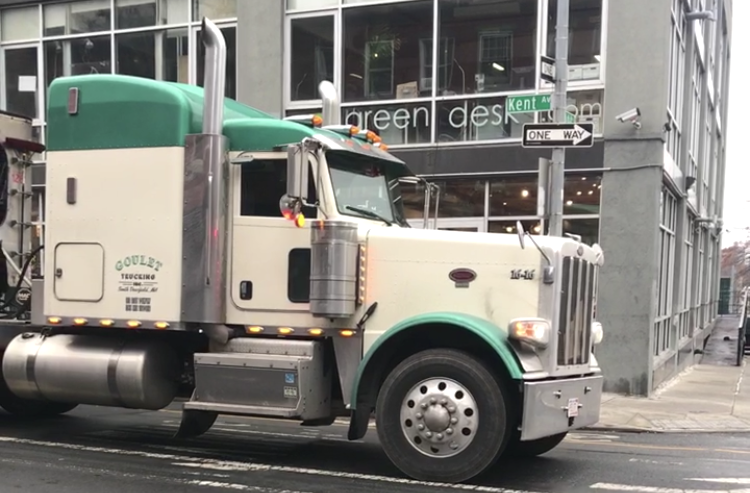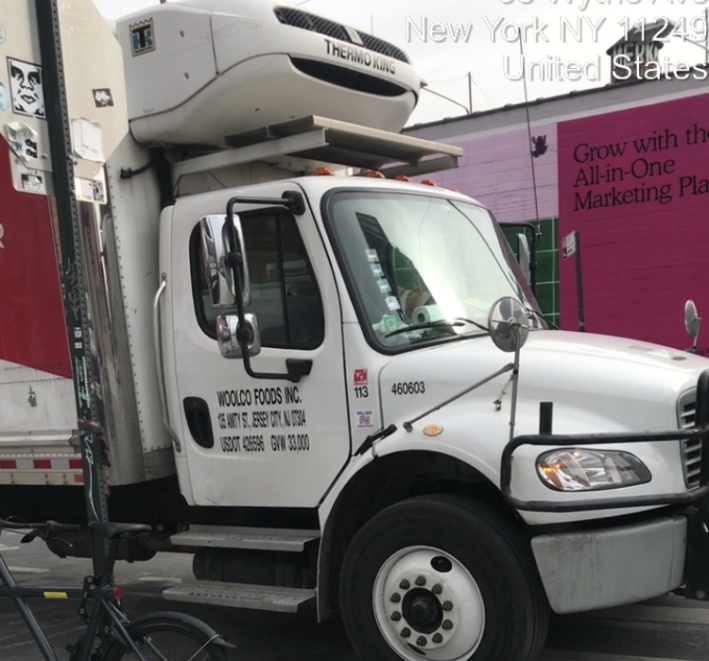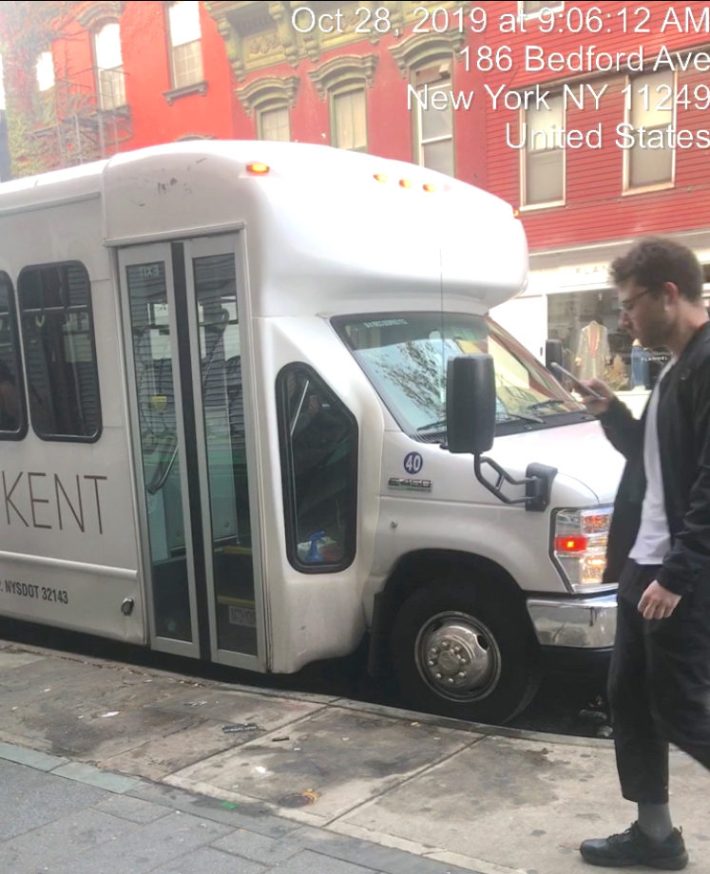Dear Diary: How I Caught My First Idler
12:01 AM EST on February 11, 2020

Hey, idling polluters! An army of empowered citizens is coming to report you! Above, an idling truck on Kent Avenue in Brooklyn. Photo: Lael Goodman
The law is clear: Drivers who idle their engines for more than three minutes while parked in New York City (one minute in front of a school) can be fined from $350 to $2,000 (for a repeat offense) for polluting our air. And, since Local Law 717A passed in 2018, New Yorker who report idling commercial trucks, vans and buses get 25 percent of any fine imposed by the Department of Environmental Protection — empowering a citizen army to catch polluters. Lots of people are taking up the call.
It's easy enough to find drivers idling for more than three minutes. They're everywhere — delivering goods, stopping at construction sites, or just hanging out on the street. But how easy is it to successfully document instances of idling? Well, it's not as easy as you’d think.
You need to make sure that you take a video of the proper length and that it is date- and time-stamped for veracity, that you document the offending truck from multiple angles and get a picture of its license-plate, and that you notarize your complaint and submit it properly through the DEP portal.
And even though I'm the Environmental Justice Program manager for North Brooklyn Neighbors, an environmental and community planning nonprofit, I had to practice a few times before I succeeded in obtaining the evidence for a submission to the Idling Complaint page on the city's website.
Following are my “idling diaries” — describing three attempts and, finally, success! — in hopes that others can learn from my experiences.
First Attempt
Location: Kent Avenue and North Fifth Street
I filmed a delivery truck for more than three minutes and took photos of its license plate, its U.S. Department of Transportation number, and nearby street signs. I was pleased with myself until I reviewed the evidence: I had forgotten to use the time-and-date stamp app. While I still could have submitted the evidence, the case may not have been strong enough to move forward. Rookie mistake.
Takeaway: Use the time/date stamp app.
Second Attempt
Location: Kent Avenue and North First Street
For weeks, drivers idled trucks on the street in front of a construction site near our office. Fed up with the noise, I took a time-stamped video of a truck that was waiting to be filled with contaminated soil. I stayed near the back of the truck so as not to attract notice. But on reviewing the video, I realized that the dominant motor sound was coming from the truck behind me, not the truck I was filming, and I had not gotten the license plate or DOT number for that truck. I counted it as another learning experience and kept my eyes peeled for the next infraction.
Takeaway: Stand near the front of the cab to ensure the engine idling is clearly audible.
Third Attempt
Location: Wythe Avenue and North 11th Street

During my third filming attempt, I noticed that the the truck had a Thermo King auxiliary power unit atop the cab. The truck’s engine was idling, but it was difficult to tell from the video whether the noise was coming from the engine or from the auxiliary unit. I also neglected to get a shot of the back of the truck, to show that no lift gate was in operation (which would make the idling legal).
Takeaway: Film the vehicle from many angles. Refrigerated trucks present special challenges.
Success!
After these "practice" experiences, I was determined to learn from my mistakes, and hit the streets with renewed fervor.

My target was a shuttle bus idling outside the Bedford Avenue L-train entrance. I first did a mental assessment to make sure the shuttle bus qualified — such buses may idle if the engine is heating or cooling passengers. There were seats for at least 15 passengers, but I couldn’t see any passengers through the windows. Also, no passengers were entering or exiting the vehicle and the temperature outside was a balmy 60 degrees. It seemed to fit all the criteria for a successful idling complaint. I hit record.
This was by far the easiest idling instance I documented. It’s best to look inconspicuous to avoid confrontation while catching an idler, and that was easy on bustling Bedford Avenue. I brainstormed several cover stories should the bus driver confront me: I was meeting a friend to take the L into Union Square; my husband was getting a bagel with cream cheese at nearby Bagelsmith; or I was waiting for a Lyft and watching its progress on my cell phone.
Three minutes passed. Then, I realized that I had forgotten to take any photos. At the workshop, I had learned that photo evidence is as vital as video, because videos can have technical issues. Luckily, I also learned that you can take video stills to serve as photographic evidence, so I took some screenshots and got ready to make my first submission.
Submitting a Complaint
To create an account at the DEP portal requires answering some basic questions that determine whether the vehicle can be reported, along with contact information. Using the DOT number from the vehicle, I was able to look up details on the company that I was reporting (critically, the fine is levied on the truck or bus company and not the individual driver), then typed up the details (including location of the incident, license plate, etc.) into a written statement.
Because I do not want to appear for any court date arising from the summons, I said I would not be able to attend the court meeting. Instead, I filled out a Citizen’s Air Complaint Affidavit, which was provided on the site. I then printed out the affidavit to be notarized. Once notarized (notaries can be found at many banks), I submitted the complaint through the website, receiving a confirmation email and a complaint number.
About two weeks later, I received another email stating that the DEP had accepted my complaint and the supporting documentation and that its air-pollution inspector would issue a summons. Information on the summons's number, hearing date and instructions will be sent separately, the agency said. I have yet to receive it — the process can take many months — but, for now, my work is done.
On to the next!
Lael Goodman (@NBKLYNNEIGHBORS) is the environmental justice program manager for North Brooklyn Neighbors. The group's next idling workshop is April 2.
Read More:
Stay in touch
Sign up for our free newsletter
More from Streetsblog New York City
Thursday’s Headlines: Speed-Limiting Tech Edition
State Sen. Andrew Gounardes continues his push to force reckless drivers to install speed limiters in their cars. Plus more news.
DOT Official: All Our Free Parking Justifies Keeping Curb Space for EVs
If only someone could do something about the parking!
New York City to Install 500 Secure Bike Parking Hubs In The Next Five Years: Sources
Your bike may finally get a roof over its head.
Adams Backs Lower Speed Limits, Calls Crashes ‘Accidents’
The mayor wants New York City drivers to "slow down," but it's not clear yet how many streets will get lower speed limits.
Wednesday’s Headlines: Trump Posts About Congestion Pricing Edition
Donald Trump comments on congestion pricing — no surprise, he's against it. Plus more news.





